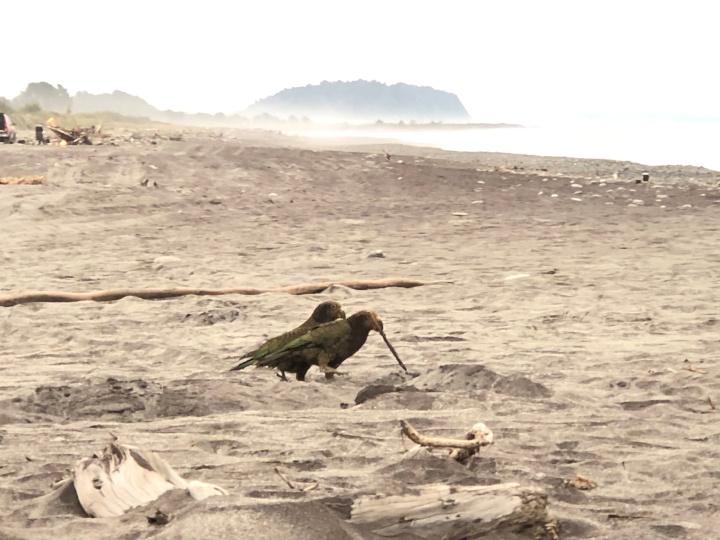Juvenile kea playing on a log at Ross Beach
Kea spotted at Ross beach

Credit: Luke Leaf
A pair of kea, a native parrot most often associated with alpine environments, have been spotted at Ross Beach, south of Hokitika on the West Coast.
The two juvenile kea were spotted by a Ross local playing on a tree stump.
Nicole Kunzmann, Department of Conservation (DOC) Hokitika Operations Manager, says while kea are most often seen at higher altitudes, it is natural for kea to come right down to the coast.
“We know kea frequent the coast in Fiordland at Waitutu and Milford Sound, and also in Abel Tasman. We have even had reports of kea going out to fishing boats off Golden Bay in Tasman!”
“The kea seen near Ross Beach are juveniles that have left the nest and are exploring the world. Young kea are very inquisitive and curious and we have had reports that they are exploring around Ross township.
“We expect for some, this will be a source of delight, but for others, kea living in the area may pose some frustrations”, says Nicole Kunzmann.
“They may be attracted to property in the area because they like something there, whether it be a yard full of vehicles or a prominent tree to roost in. Young kea, like young humans will get bored and hungry and eventually move on if they find nothing to eat or play with.
“It’s really important that kea don’t learn that humans and their property are fun and a source of food. We ask that people check their properties for potential “kea toys” and food that kea might scavenge and if possible remove these items or make them unattractive.
“We can also put people in touch with the Kea Conservation Trust for advice on ways to make things unattractive to kea. At one mine-site a garden sprinkler proved to be a useful deterrent to kea that were posing a problem for the machinery there.”
Kea are a threatened endemic bird, which are fully protected under the Wildlife Act, and it is an offence to harm them. Juvenile kea have a yellow coloring around their eyes and above their bill (the cere).
Follow these guidelines if you have kea interfering with your belongings and equipment:
• DO NOT feed them.
• DO NOT interact or play with them.
• DO NOT leave food, food packaging, or food scraps anywhere they can access.
• If kea are interfering with something they shouldn’t be, DO NOT make loud noises or throw anything their direction, this just provides positive reinforcement and they will continue to return to that same activity to get the same response.
• If water is available, try and give them a good squirt with a hose to deter them from destructive activities. Make sure you are accurate and get them with the water stream otherwise it will become a game for them and they will return again for more “dodge the water”.
• DO NOT leave doors to vehicles or buildings open.
• Kea like to pull apart anything that is soft or anything that has the ability to be fit within the dimensions of their bill, so try your best to have anything that might tempt kea in covered or secure areas, e.g. put your car in the garage and cover you bike seat with a bucket.
ends


 Gordon Campbell: On America’s Fear Of Foreigners
Gordon Campbell: On America’s Fear Of Foreigners Pahiatua Polish Children: Polish And Pahiatua Communities Celebrate 80 Years Since Arrival Of Pahiatua Polish Children
Pahiatua Polish Children: Polish And Pahiatua Communities Celebrate 80 Years Since Arrival Of Pahiatua Polish Children NZ Customs Service: Customs Returns 60 Kilograms Of Pounamu To Rightful Guardians
NZ Customs Service: Customs Returns 60 Kilograms Of Pounamu To Rightful Guardians Tūpuna Maunga Authority: Devasting Fire On Maungarei / Mt Wellington Underscores Importance Of Maunga Protections
Tūpuna Maunga Authority: Devasting Fire On Maungarei / Mt Wellington Underscores Importance Of Maunga Protections NZ Government: Breast Screening Age Extension Begins In Nelson Marlborough
NZ Government: Breast Screening Age Extension Begins In Nelson Marlborough NZ Police: Police Reassure Public With High Visibility Across Network
NZ Police: Police Reassure Public With High Visibility Across Network Office of the Privacy Commissioner: Global Privacy Authorities Issue Follow-up Joint Statement On Data Scraping After Industry Engagement
Office of the Privacy Commissioner: Global Privacy Authorities Issue Follow-up Joint Statement On Data Scraping After Industry Engagement


